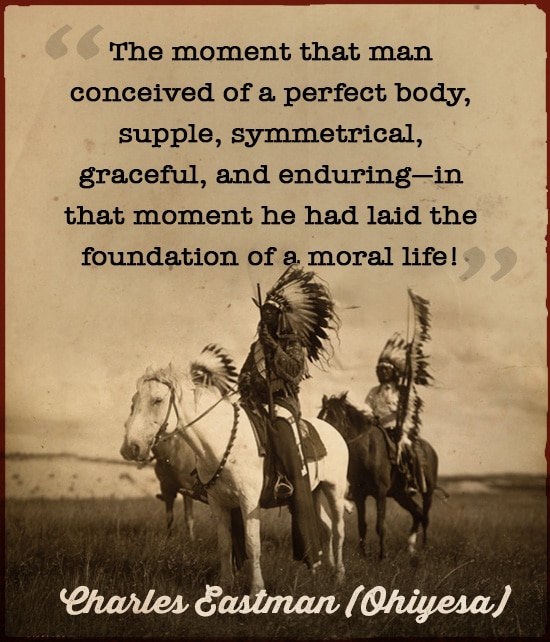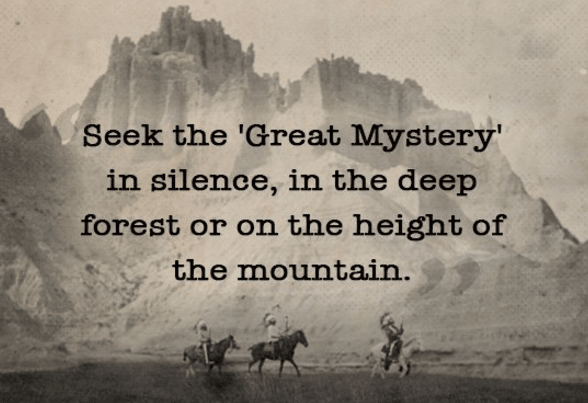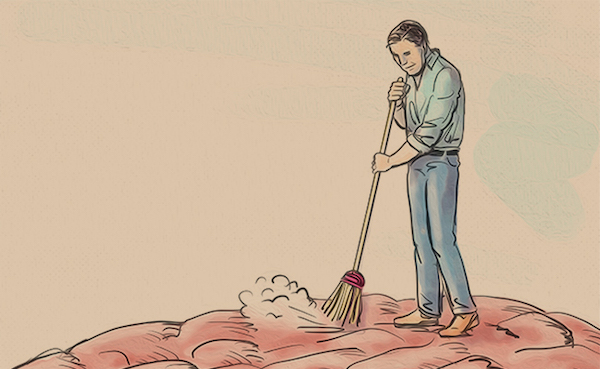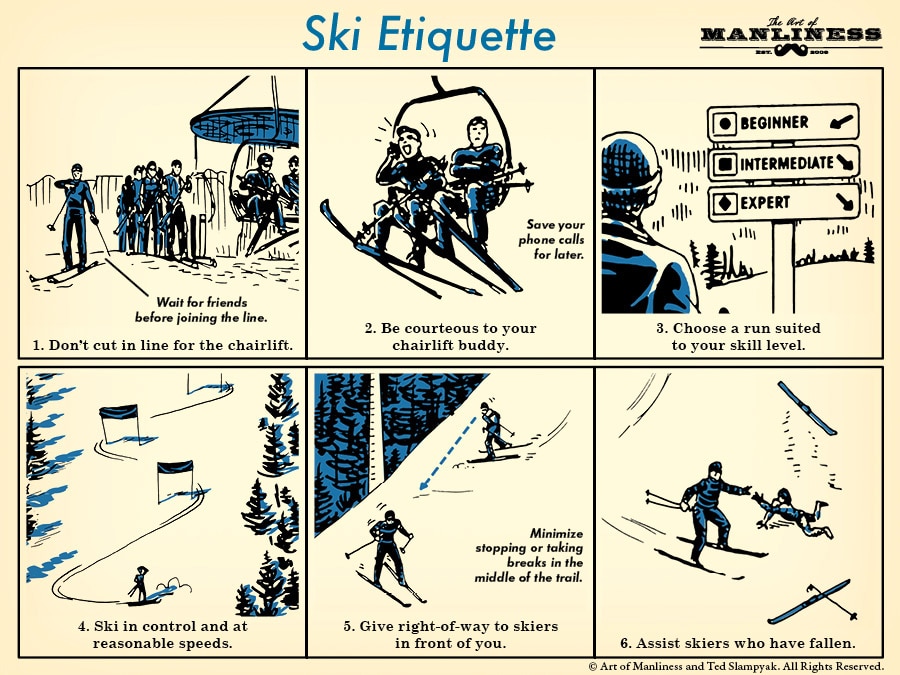Charles Alexander Eastman was born in 1858 and raised as “Ohiyesa” to be a hunter and warrior in the traditional ways of the Santee Sioux. When he was almost 16 years old, he left tribal life to learn the culture of European-American civilization and earn his undergraduate and medical degrees. Eastman became a doctor, a tireless advocate for the rights of his people, and a writer of many works in which he sought to share the true ways of the American Indian. We previously shared Eastman’s insights on the Sioux ideal of manhood. Having laid that foundational overview, we are now working our way through a series of edited collections of Eastman’s writing on 3 specific subjects: situational awareness, physical and mental toughness, and spirituality.
Living life in the wilderness offered the American Indian a freedom and autonomy those who dwelled in the cities of civilization could hardly conceive of. But such a life also came with its own dangers and struggles — challenges that required the Indian to develop a high level of both mental and physical toughness. A Sioux’s daily life called for a keen physicality; all men were hunters, and it was considered nothing special for a man to sling a deer around his shoulders and carry it many miles back to camp.
The overall cycle of native life was also seasonal and unpredictable. In the warmer months the game was plentiful and the Sioux enjoyed a variety of outdoor pastimes and celebrations. But the winters brought bitterly cold temperatures, and the need to largely live off the food that had been stored up, as well as to ride out days-long snowstorms with only a teepee as protection from the elements. In order to develop the resilience necessary to endure these ups and downs and “prepare the body for the extraordinary exertions that it might, at any moment, be required to undergo,” the Sioux intentionally trained for toughness: fasts from food and water were undertaken even when there was plenty to eat and drink, ice baths were regularly taken, and “hard exercise was kept up continually.” As a young man, Eastman exercised at least three hours a day (and even kept up this regimen throughout his college years), typically by engaging in a variety of vigorous sports and races with his peers. The Sioux placed such a heavy emphasis on physical activity, because they felt that building a young man’s fitness not only strengthened his body, but developed his ability to live a life of moral virtue and self-mastery.
Indeed, mental and physical discipline were seen as going hand-in-hand; a “trained mind” was necessary “to reach the height of one’s physical possibilities,” while physical prowess and hardihood helped the mind become more resilient and courageous. Together, these twin qualities were prerequisites to a Sioux attaining “true manhood.”
A Sioux’s all-around toughness was not cultivated merely for aesthetics (though they appreciated the beauty of a well-developed body), and using one’s physical power to engage in destructive pursuits for personal amusement was strictly condemned as an abuse of one’s strength. Instead, a man’s strength and endurance were to be developed in order that he might become a more excellent hunter and warrior and better serve his people. A Sioux man became strong to be useful.
To understand the tenets of the training “program” that was used to reach that goal, we turn now to the words of Charles Eastman.
The Sioux Guide to Mental and Physical Toughness
The Standard
The desire to be a man — the native spirit of the explorer and the hero — this is the strong inner motive which leads a boy out on the wilderness trail to discover the world anew. First of all, he discovers what he himself must be in order to overcome difficulties, to resist pain and hardship, and to win the object of his quest. With these impulses at their purest and strongest, the Indian boy begins his career with the building of a sound and efficient body.
 All boys were expected to endure hardship without complaint. In savage warfare, a young man must, of course, be an athlete and used to undergoing all sorts of privations. He must be able to go without food and water for two or three days without displaying any weakness, or to run for a day and a night without any rest. He must be able to traverse a pathless and wild country without losing his way either in the day or nighttime. He cannot refuse to do any of these things if he aspires to be a warrior.
All boys were expected to endure hardship without complaint. In savage warfare, a young man must, of course, be an athlete and used to undergoing all sorts of privations. He must be able to go without food and water for two or three days without displaying any weakness, or to run for a day and a night without any rest. He must be able to traverse a pathless and wild country without losing his way either in the day or nighttime. He cannot refuse to do any of these things if he aspires to be a warrior.
 The moment that man conceived of a perfect body, supple, symmetrical, graceful, and enduring — in that moment he had laid the foundation of a moral life! No man can hope to maintain such a temple of the spirit beyond the period of adolescence, unless he is able to curb his indulgence in the pleasures of the senses. Upon this truth the Indian built a rigid system of physical training, a social and moral code that was the law of his life. There was aroused in him as a child a high ideal of manly strength and beauty, the attainment of which must depend upon strict temperance in eating and in the sexual relation, together with severe and persistent exercise. He desired to be a worthy link in the generations, and that he might not destroy by his weakness that vigor and purity of blood which had been achieved at the cost of much self-denial by a long line of ancestors.
The moment that man conceived of a perfect body, supple, symmetrical, graceful, and enduring — in that moment he had laid the foundation of a moral life! No man can hope to maintain such a temple of the spirit beyond the period of adolescence, unless he is able to curb his indulgence in the pleasures of the senses. Upon this truth the Indian built a rigid system of physical training, a social and moral code that was the law of his life. There was aroused in him as a child a high ideal of manly strength and beauty, the attainment of which must depend upon strict temperance in eating and in the sexual relation, together with severe and persistent exercise. He desired to be a worthy link in the generations, and that he might not destroy by his weakness that vigor and purity of blood which had been achieved at the cost of much self-denial by a long line of ancestors.
Mental and Emotional Self-Mastery
As a little child, it was instilled into me to be silent and reticent. This was one of the most important traits to form in the character of the Indian. As a hunter and warrior it was considered absolutely necessary to him, and was thought to lay the foundations of patience and self-control. There are times when boisterous mirth is indulged in by our people, but the rule is gravity and decorum.
 The first American believed profoundly in silence — the sign of a perfect equilibrium. Silence is the absolute poise or balance of body, mind, and spirit. The man who preserves his selfhood ever calm and unshaken by the storms of existence — not a leaf, as it were, astir on the tree; not a ripple upon the surface of shining pool — his, in the mind of the unlettered sage, is the ideal attitude and conduct of life. If you ask him: “What is silence?” he will answer: “It is the Great Mystery!” “The holy silence is His voice!” If you ask: “What are the fruits of silence?” he will say: “They are self-control, true courage or endurance, patience, dignity, and reverence. Silence is the cornerstone of character.” “Guard your tongue in youth,” said the old chief, Wabashaw, “and in age you may mature a thought that will be of service to your people!”
The first American believed profoundly in silence — the sign of a perfect equilibrium. Silence is the absolute poise or balance of body, mind, and spirit. The man who preserves his selfhood ever calm and unshaken by the storms of existence — not a leaf, as it were, astir on the tree; not a ripple upon the surface of shining pool — his, in the mind of the unlettered sage, is the ideal attitude and conduct of life. If you ask him: “What is silence?” he will answer: “It is the Great Mystery!” “The holy silence is His voice!” If you ask: “What are the fruits of silence?” he will say: “They are self-control, true courage or endurance, patience, dignity, and reverence. Silence is the cornerstone of character.” “Guard your tongue in youth,” said the old chief, Wabashaw, “and in age you may mature a thought that will be of service to your people!”
 I recall to the present day some of the kind warnings and reproofs that my good grandmother was wont to give me. “Be strong of heart — be patient!” she used to say. She told me of a young chief who was noted for his uncontrollable temper. While in one of his rages he attempted to kill a woman, for which he was slain by his own band and left unburied as a mark of disgrace — his body was simply covered with green grass. If I ever lost my temper, she would say:
I recall to the present day some of the kind warnings and reproofs that my good grandmother was wont to give me. “Be strong of heart — be patient!” she used to say. She told me of a young chief who was noted for his uncontrollable temper. While in one of his rages he attempted to kill a woman, for which he was slain by his own band and left unburied as a mark of disgrace — his body was simply covered with green grass. If I ever lost my temper, she would say:
“Hakadah, control yourself, or you will be like that young man I told you of, and lie under a green blanket!”
 Smoky Day was widely known among us as preserver of history and legend. He was a living book of the traditions and history of his people. I went to him one day with a piece of tobacco and an eagle-feather, hoping for the privilege of hearing him tell of some of the brave deeds of our people in remote times.
Smoky Day was widely known among us as preserver of history and legend. He was a living book of the traditions and history of his people. I went to him one day with a piece of tobacco and an eagle-feather, hoping for the privilege of hearing him tell of some of the brave deeds of our people in remote times.
“Ah, Ohiyesa!” said he, “my young warrior — for such you will be some day! I know this by your seeking to hear of the great deeds of your ancestors. That is a good sign, and I love to repeat these stories to one who is destined to be a brave man. I do not wish to lull you to sleep with sweet words; but I know the conduct of your paternal ancestors. They have been and are still among the bravest of our tribe. To prove this, I will relate what happened in your paternal grandfather’s family, twenty years ago.
“Two of his brothers were murdered by a jealous young man of their own band. The deed was committed without just cause; therefore all the braves were agreed to punish the murderer with death. When your grandfather was approached with this suggestion, he replied that he and the remaining brothers could not condescend to spill the blood of such a wretch, but that the others might do whatever they thought just with the young man. These men were foremost among the warriors of the Sioux, and no one questioned their courage; yet when this calamity was brought upon them by a villain, they refused to touch him! This, my boy, is a test of true bravery. Self-possession and self-control at such a moment is proof of a strong heart.”
Mentorship & The Art of Tactical Swimming
As a very young child he starts in to swim, as naturally, almost, as he begins to walk. The writer barely remembers standing on the white, pebbly beach with his grandfather at his side; standing silent, full of sincere reverence for the spirit of the deep, as he stood before the towering cliff, or the majestic, solitary tree. In advance of every undertaking, the Indian loves to meet thus the all-pervading Spirit in the attitude of wordless prayer.
Now the grandfather makes the plunge with a boyish shout. “See, see!” he calls to the boy as he comes up, breathless and exultant, from his dive. “I am happy as I lie here cradled by the yielding water. You can be as happy, if you will but make up your mind to try!”
Do you see the idea? The simple effort, the plunge, that is the important thing. The boy is neither frightened nor forced; he follows soon of his own accord, and the lesson is begun aright under the eye of an experienced master.
As the child grows, he becomes more and more expert and daring; from this time on he eagerly seeks perfection in his new art. His idea of perfection is, first, endurance, then swiftness; grace and form come naturally while aiming at these two. Therefore he swims at all times, in rough water and against strong currents. When some day he is cast suddenly into the water at a disadvantage, wounded, it may be, or obliged to swim long under water in order to escape the enemy, he knows how to utilize his strength to the utmost, and often overcomes tremendous odds with the remarkable tact and skill of the Indian athlete.
It is not my purpose to teach you to swim, but to tell you how to use the art of swimming toward perfecting an out-of-door body and a logical mind.
Cold Exposure Training
The usual method of bathing in winter is to go into a sweat lodge for five or more minutes; then he jumps into a hole in the ice, which he has cut large enough to enter safely, and comes out in a few minutes. After a short run, he wraps himself in a buffalo robe with the hair inside and sleeps for a while. This makes him a new man. The Indian boy often rolls in the snow naked when fresh snow is on the ground.
A perfectly trained outdoor man has much natural heat in his body, and can generate much more by exercise. Little clothing is actually needed, and I have seen Indians sleep all night without covering, in fairly cool weather at that. Much depends upon habit and early training; yet it is quite possible to learn new habits after one is well grown.
One of the first things to do is to accustom yourself to lie on the ground until your muscles make the necessary adjustment to its hardness and unevenness, and you can rest in comfort. Do not worry about snakes or insects; they will rarely do you harm; nor is there any danger from dampness, once you are in training. A few evergreen boughs over frozen or wet ground are protection enough. The best way to sleep in camp is feet toward the fire. There are several reasons for this. If, by any mischance, the fire escapes, your feet are very sensitive and will awaken you in time. Also, it is easy to get up without disturbing any one.
 Before winter sets in, he begins to take ice-cold foot-baths, and as soon as the first snow comes, he walks barefoot in it until he gets up a fine glow; then puts on warm, fur-lined moccasins. He is perfectly able to enjoy life out-of-doors at any season of the year, and has no use for the artificial house-heat of civilization. If he wets his feet at any time, he puts dry hair or even grass inside his moccasins, and runs until his feet are dry and warm.
Before winter sets in, he begins to take ice-cold foot-baths, and as soon as the first snow comes, he walks barefoot in it until he gets up a fine glow; then puts on warm, fur-lined moccasins. He is perfectly able to enjoy life out-of-doors at any season of the year, and has no use for the artificial house-heat of civilization. If he wets his feet at any time, he puts dry hair or even grass inside his moccasins, and runs until his feet are dry and warm.
Diet and Fasting
The usual custom with us was to eat only two meals a day and these were served at each end of the day. This rule was not invariable, however, for if there should be any callers, it was Indian etiquette to offer either tobacco or food, or both. The rule of two meals a day was more closely observed by the men — especially the younger men — than by the women and children.
 His best meal is in the evening, when he eats heartily, sometimes taking another meal later in the night. His breakfast is a light one, and if he expects to run much, he eats nothing at all. At noon, he cooks some game for himself, if convenient. An occasional short fast is enjoined upon the Indian boy, as a means of developing his endurance and self-restraint.
His best meal is in the evening, when he eats heartily, sometimes taking another meal later in the night. His breakfast is a light one, and if he expects to run much, he eats nothing at all. At noon, he cooks some game for himself, if convenient. An occasional short fast is enjoined upon the Indian boy, as a means of developing his endurance and self-restraint.
 Sometimes my uncle would waken me very early in the morning and challenge me to fast with him all day. I had to accept the challenge. We blackened our faces with charcoal, so that every boy in the village would know that I was fasting for the day. Then the little tempters would make my life a misery until the merciful sun hid behind the western hills.
Sometimes my uncle would waken me very early in the morning and challenge me to fast with him all day. I had to accept the challenge. We blackened our faces with charcoal, so that every boy in the village would know that I was fasting for the day. Then the little tempters would make my life a misery until the merciful sun hid behind the western hills.
Morning Routine
An Indian must always rise early. In the first place, as a hunter, he finds his game best at daybreak. Secondly, other tribes, when on the war-path, usually make their attack very early in the morning. Even when our people are moving about leisurely, we like to rise before daybreak, in order to travel when the air is cool, and unobserved, perchance, by our enemies.
 The Indian must always arouse every fiber of his body before he begins the day. The first thing he does when he awakes is to stretch every limb to the utmost, and finally the entire body. He takes pleasure in the most tremendous yawns. He rises and starts up the fire; then he runs to the nearest stream or lake shore and either plunges in or splashes the fresh cold water upon his face, chest, and arms. Often he holds his face and eyes under water for several seconds. After that, he rinses his mouth and throat, rubs himself vigorously with the palms of his hands, and combs his hair, with the placid pool or spring for his only mirror.
The Indian must always arouse every fiber of his body before he begins the day. The first thing he does when he awakes is to stretch every limb to the utmost, and finally the entire body. He takes pleasure in the most tremendous yawns. He rises and starts up the fire; then he runs to the nearest stream or lake shore and either plunges in or splashes the fresh cold water upon his face, chest, and arms. Often he holds his face and eyes under water for several seconds. After that, he rinses his mouth and throat, rubs himself vigorously with the palms of his hands, and combs his hair, with the placid pool or spring for his only mirror.
 In awakening his sleeping body, the Indian patterns after his animal friends. You will observe that no dog gets up and walks off without thoroughly stretching himself, from the nose to the tip of his tail. This is an excellent cure for early morning laziness.
In awakening his sleeping body, the Indian patterns after his animal friends. You will observe that no dog gets up and walks off without thoroughly stretching himself, from the nose to the tip of his tail. This is an excellent cure for early morning laziness.
Satisfying Sleep
Although trained from babyhood to awaken easily, his sleep is sound and sweet; such sleep as comes after a day of healthful bodily exercise in the open air, when a good evening meal and the warmth of a cheerful campfire bring on that delicious drowsiness to which it is a luxury to yield.
Read the Entire Series:
Read the Entire Series:
Lessons from the Sioux in How to Turn a Boy into a Man
The Sioux Guide to Situational Awareness
The Sioux Guide to Spirituality
__________________________________________
Sources and Further Reading:









